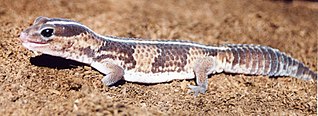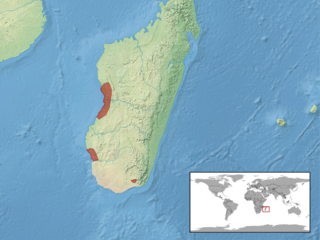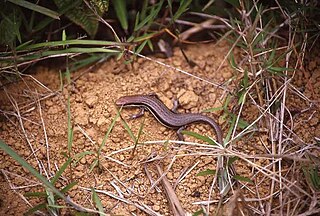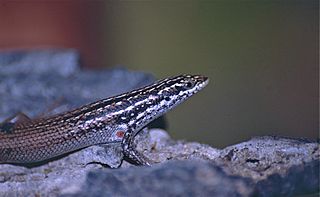
The African fat-tailed gecko or fat-tail gecko is a ground-dwelling species of gecko from West Africa and Cameroon.

The Senegal flapshell turtle is a species of turtle in the subfamily Cyclanorbinae of the family Trionychidae. The species, which is one of two species of softshell turtles in the genus Cyclanorbis, is endemic to Africa.

Trachylepis is a skink genus in the subfamily Mabuyinae found mainly in Africa. Its members were formerly included in the "wastebin taxon" Mabuya, and for some time in Euprepis. As defined today, Trachylepis contains the clade of Afro-Malagasy mabuyas. The genus also contains a species from the Brazilian island of Fernando de Noronha, T. atlantica, and may occur in mainland South America with Trachylepis tschudii and Trachylepis maculata, both poorly known and enigmatic. The ancestors of T. atlantica are believed to have rafted across the Atlantic from Africa during the last 9 million years.

The common agama, red-headed rock agama or rainbow agama is a species of lizard from the family Agamidae found in most of sub-Saharan Africa. To clear up historical confusion based on Linnaeus and other authors, Wagner, et al. (2009) designated a neotype for the species, using a previously described specimen from Cameroon in the collection of the Zoologisches Forschungsmuseum Alexander Koenig in Bonn. The species name was formerly applied to a paraphyletic collection of taxa, and mitochondrial DNA analysis of various populations indicates they represent separate species., Consequently, three former subspecies A. a. africana, A. a. boensis, and A. a. mucosoensis are now considered separate species, and A. a. savattieri is considered synonymous with A. africana.
Chalcides thierryi, commonly known as Thierry's cylindrical skink, is a species of lizard in the family Scincidae. The species is indigenous to West Africa.

The fire skink, also known commonly as Fernand's skink, the Togo fire skink, and the true fire skink, is a fairly large skink, a species of lizard in the family Scincidae. The species is known for its bright and vivid coloration. Native to tropical forests in West and Central Africa, the fire skink lives fifteen to twenty years. This species is a diurnal lizard that burrows and hides. It is relatively shy and reclusive, but may become tame in captivity.

The rainbow skink is a species of Afro-Malagasy mabuya or skink in the subfamily Lygosominae.

The African five-lined skink, sometimes called rainbow mabuya, is a species of African skink in the subfamily Lygosominae. T. margaritifera is also known as the rainbow skink.

The Noronha skink is a species of skink from the island of Fernando de Noronha off northeastern Brazil. It is covered with dark and light spots on the upperparts and is usually about 7 to 10 cm in length. The tail is long and muscular, but breaks off easily. Very common throughout Fernando de Noronha, it is an opportunistic feeder, eating both insects and plant material, including nectar from the Erythrina velutina tree, as well as other material ranging from cookie crumbs to eggs of its own species. Introduced predators such as feral cats prey on it and several parasitic worms infect it.

Trachylepis capensis is a species of skink, a lizard in the family Scincidae. The species is native to southern Africa.
Trachylepis ferrarai, also known commonly as Ferrara's mabuya, is a species of skink, a lizard in the family Scincidae. The species is endemic to Somalia.
Trachylepis bayonii, also known commonly as Bayão's skink, Bayon's mabuya, and Bayon's skink, is a species of lizard in the family Scincidae. The species is endemic to Africa. There are two subspecies.
Trachylepis rodenburgi, also known commonly as Rodenburg's mabuya, is a species of skink, a lizard in the family Scincidae. The species is endemic to West Africa.
Acanthodactylus boueti, also known commonly as Chabanaud's fringe-fingered lizard, is a species of lizard in the family Lacertidae. The species is native to West Africa.

Benson's mabuya is a species of skink, a lizard in the family Scincidae. The species is native to Western Africa.

Trachylepis dumasi is a species of skink, a lizard in the family Scincidae. The species is endemic to Madagascar.

Trachylepis gravenhorstii, also known commonly as Gravenhorst's mabuya, is a species of skink, a lizard in the family Scincidae. The species is endemic to Madagascar.
Trachylepis hemmingi, also known commonly as the Somali mabuya, is a species of skink, a lizard in the family Scincidae. The species is endemic to Somalia.

Trachylepis nancycoutuae, also known commonly as Nancy Coutu's mabuya and Nancy Coutu's skink, is a species of lizard in the family Scincidae. The species is endemic to Madagascar.

Trachylepis perrotetii, also known commonly as the African red-sided skink, the red-sided skink, and the Teita mabuya, is a species of lizard in the family Scincidae. The species is endemic to Africa.














